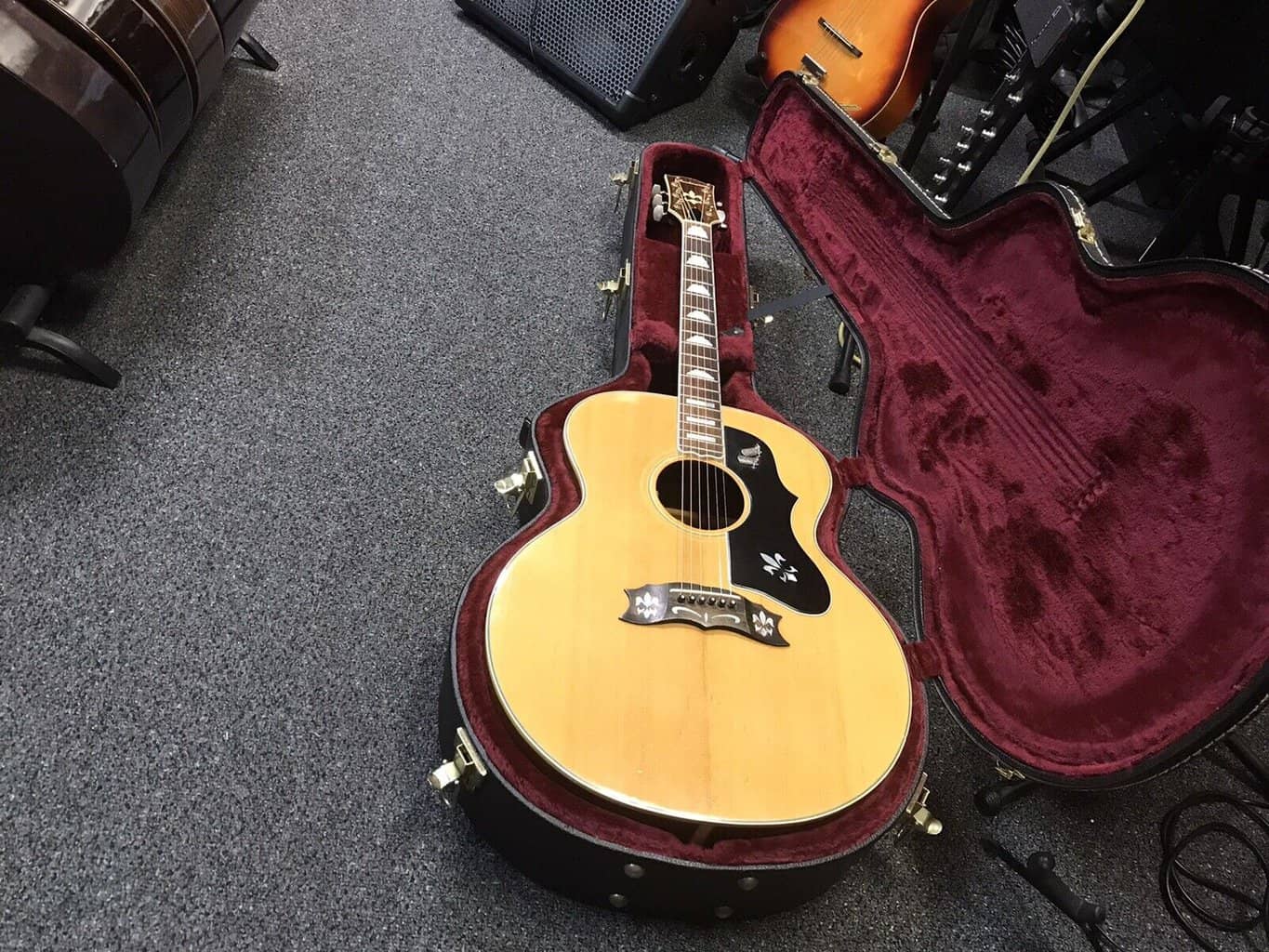When it comes to jumbo vs dreadnought acoustics, which one should you choose?
Is bigger better?
What are the key differences between jumbo vs dreadnought acoustics?
The aptly named jumbo is the largest acoustic guitar you can get in the market today. Its size gives it a larger, fuller sound than the dreadnought. But therein lies the problem: its size can be its downside. Sometimes being physically bigger just isn’t better.
But let’s try to look at these two guitars deeper and find out what their key differences are.
That way, you can have all the info you need to choose the right guitar for yourself. Find out more about jumbo vs dreadnought acoustics below.
1. Size
Let’s get this one out of the way immediately:
The jumbo is definitely a bigger guitar.
In fact, it is the biggest body type for all guitars that fall under the acoustic guitar umbrella.
Although at first glance it may not seem so, placing it beside a dreadnought will reveal just how much size difference is present between the two.
This visual deception is caused by the curves present on the jumbo which is absent on the dreadnought.
In fact, the dreadnought’s blocky appearance makes it seem larger than the jumbo.
Here are the technical specifications between jumbo vs dreadnought acoustics that relay the size difference between the two.
| Measure | Dreadnought | Jumbo |
| Total Body Length | 20 inches | 21 inches |
| Lower Bout Measurement | 15.6 inches | 17 |
| Upper Bout Measurement | 11.5 inches | 12.25 inches |
| Body Depth | 4.6 inches | 4.75 inches |
Despite its larger body size, the neck remains more or less the same as that of a dreadnought or an auditorium.
There’s no need to worry about getting bigger hands just to play this instrument.
2. Shape
The dreadnought has the “classic” acoustic lines that everyone has become accustomed to over the years.
It is basically the simple, boxy look that gives the dreadnought a solid appearance.
The jumbo, although bigger overall, has a curvier appearance.
This is brought about by its extremely slim (for its size) waist and curved shoulders.
There may or may not be embellishments on its body like the pickguard or a circular frame running along its sound hole.
From a distance, and on its own, the jumbo looks very much like any other type of acoustic guitar.
The only time it becomes evident that it is a bigger instrument is when you approach it for a closer look or if there are other things to scale beside it.
Think of the jumbo as an auditorium or concert model in a larger format.
3. Volume
It’s not surprising that the jumbo is louder than the dreadnought.
The size of the sound chamber dictates the volume an acoustic guitar can produce.
A small difference in size can mean a louder sound.
Even a small increment is enough to add a few decibels into the guitar’s output.
So, yes, the jumbo is louder than the dreadnought.
But what does it mean for the aspiring guitarist looking at the jumbo as their next instrument?
Well, this means the jumbo can act as a background or rhythm instrument.
Rather than act as a lead instrument, the jumbo can display its full value by lending its volume as a steady musical foundation for other musicians to play along with or play lead melodies on top of it.
4. Tone
The jumbo produces a snappy sound. This is due to the fact that it has a larger body but a smaller waist as compared to a dreadnought.
This means that the sound that enters into the jumbo’s sound hole escapes in a sequential manner based on frequency.
This gives the jumbo a more pronounced treble and bass sound.
The mids come in slightly out of phase due to it lingering within the chamber before joining the mix.
This is the initial sound you will get.
The dreadnought on the other hand is a great all-rounder. It has a balanced mix of treble, bass, and mids that the jumbo can’t replicate.
Equipping the jumbo with heavier strings will make the bass sound more pronounced and the higher register strings sing.
Be careful though, equipping the wrong strings can damage your guitar’s neck.
5. Target Users
For the jumbo, the target users are:
- Players looking for a loud guitar that doesn’t need additional amplification to entertain a crowd.
- Guitarists who are part of an acoustic group that needs more bottom end in the mix.
- Players who like hearing the bass and treble sound when playing.
- Bigger guitar players who want an instrument that doesn’t look too tiny in their hands
- Guitar collectors who like having odd, weird, strange, and/or amusing guitars in their collection.
- Someone specifically looking for a jumbo acoustic guitar.
The dreadnought on the other hand is a guitar that anyone would love to have.
6. Price
All that extra wood is going to mean additional dollars on top of the expected price. This can also be affected by the brand the guitar is produced under.
Normally, the jumbo would cost more than the commonly-found dreadnought.
But there’s no way a jumbo produced by Yamaha is going to cost more than a dreadnought produced by either Takamine or Gibson.
So, the price is up for debate with these two.
Which One Should You Get?
We’ve come to an end in our jumbo vs dreadnought acoustics comparison. So, which one should you get?
It all ultimately boils down to your preference.
Personally, I’d choose the dreadnought because it has everything I need and then some.
The jumbo, although louder, doesn’t really offer much in the way of sound quality or tone.
Volume can always be adjusted by your pick attack or employing the use of additional amplification.
But if there’s one thing that would push me to get a jumbo, it’s this: it’s the guitar Bob Dylan used to make him a legend.
So, maybe there’s something about the jumbo that should make you reconsider its value not just as a musical instrument but as a potential culture changer.

Hello there, my name is Ramiro and I’ve been playing guitar for almost 20 years. I’m obsessed with everything gear-related and I thought it might be worth sharing it. From guitars, pedals, amps, and synths to studio gear and production tips, I hope you find what I post here useful, and I’ll try my best to keep it entertaining also.





